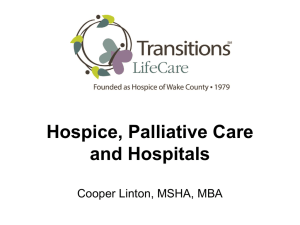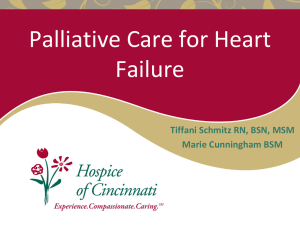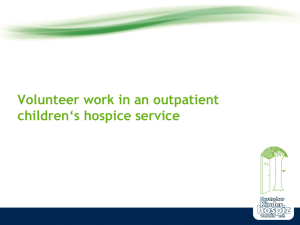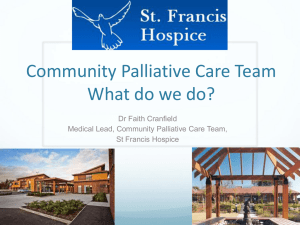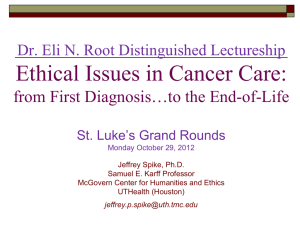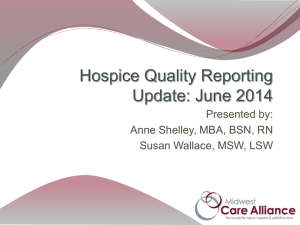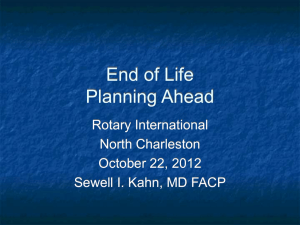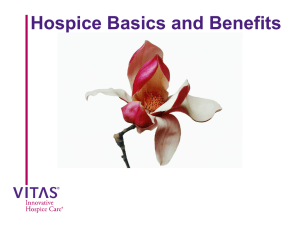Transitions - American Hospital Association
advertisement
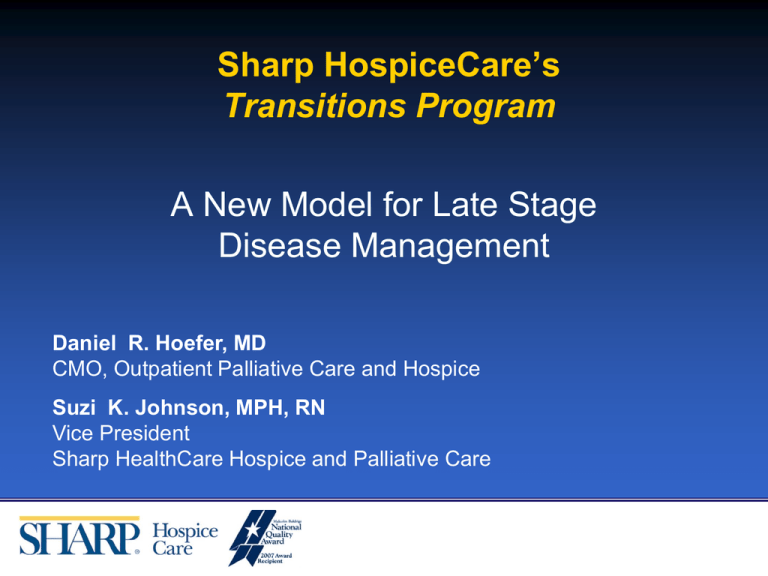
Sharp HospiceCare’s Transitions Program A New Model for Late Stage Disease Management Daniel R. Hoefer, MD CMO, Outpatient Palliative Care and Hospice Suzi K. Johnson, MPH, RN Vice President Sharp HealthCare Hospice and Palliative Care • First generation outpatient palliative care • Second generation outpatient palliative care 1. UCSF 2. Kaiser 3. Sutter (AIM) 4. VA 5. Care More 6. Health Care Partners 7. Partners Medical Group (Boston) 8. University of Pittsburgh 9. Long Island Jewish 10. Hospice of the Valley 11. Sharp HealthCare Goals CMS Goals: 1.Better individual patient care 2.Better population care 3.Lower growth in health care expenditures 4.Prevent readmissions Sharp Transitions Goals: 1.Better individual patient care 2.Better population care 3.Reverse the growth in heath care expenditures 4.Better professional caregiver support 5.Better professional family support and conflict resolution 6.Prevent any admissions including primary admissions Principles of Transitions • Proactive In home Disease Management • Proactive Psychosocial Management • Accurate description of what the health care industry can and cannot provide Cultural Mind Shift “The continued application of traditional treatment strategies which are valuable to the patient at an earlier time in their health experience has the opposite effect on patients at end of life resulting in inferior outcomes.” Daniel Hoefer, MD CMO, Outpatient Palliative Care and Hospice Sharp HospiceCare Issues Important in the Management of a Pre-terminal Aging Population: Mobility Deficit Transportation Deficit Financial Restraint Social Support/Family Deficit Cognitive Deficit Compliance Deficit Change in Goals of Care It is better to bring healthcare to patients at this time, than to bring patients to healthcare. Current Culture of Health Care • Reactive versus Proactive • Paternalistic • Dependent The Traditional Medical Model “This Disease Can Be Cured” 27% of patients with incurable terminal disease believed they could have been cured Unresectionable non-small-cell lung cancer 54% AIDS 32% CHF 22% ALS 16% COPD 12% Daniel P Sulamsy, OFM, MD, PhD, et al, The Accuracy of Substituted Judgment in Patients with Terminal Diagnoses, April 1998, Annals of Internal Medicine, Vol 128(8), PP 621-29 Hospitalizations last year of life - CHF Acceptable or Not? • Historical average hospitalizations for CHF during the last year of life 3.5 Where Patients with CHF Die Acceptable or Not? • Historically 63% of CHF patients died in the hospital (2005) Expanding the Care Continuum • • • • • Home Setting Focus on high risk late stage chronic illnesses Skilled Clinicians Flexible Models Cost efficient Four Pillars of Transitions Extending the evidence based benefits of Hospice Care to patients at an earlier point in their healthcare. Comprehensive in-home patient and family education about their disease process; proactive medical management Evidence-based Prognostication Professional Proactive Management of the Caregiver Advance Health Care Planning Pillar One In Home Proactive Disease Management Registered Nurse Medical Social Worker Spiritual Care Primary Care MD Palliative Care MD Decrease Primary Admissions & Re-admissions Improved Symptom Management Improved Compliance Improved Disease Management The best medication reconciliation occurs in the home Pillar Two Evidenced-Based Medical Prognostication 1. 2. 3. 4. 343 doctors Estimates on 468 terminally ill patients Mean patient survival – 24 days Considered accurate if estimate within 33% for any give patient 5. 20% of the time accurate a. 80% of the time inaccurate b. 63% over-optimistic British Medical Journal; Extent and Determinants of Error in Doctors Prognoses in Terminally Ill patients; Prospective Cohort Study; Vol 320(7233), 19 Feb 2000 pp.469-473 The Clinical Consequences of Institutionalized Over-optimism (Pillar Two Continued) 6. The average over-optimistic estimate was off by 530% a. Increases the risk that treatment decisions by patients, families and healthcare providers are NOT consistent with reality b. Leaves patients and families emotionally unready for inevitable outcomes c. Increase risk that providers will lose credibility British Medical Journal; Extent and Determinants of Error in Doctors Prognoses in Terminally Ill patients; Prospective Cohort Study; Vol 320(7233), 19 Feb 2000 pp.469-473 Diagnosis and Treatment vs. Diagnosis, Treatment and Prognosis Biometric models + functional decline patterns + specific biological data + general biological data + adjusting for your personal tendencies = accurate, effective, professional and compassionate information. Event Prognostication – Prognostication which guides the patient in an expected series of events. Anticipatory Guidance CHF 82 Year old male Co-managed with specialist Functional Decline Progressive decline SOB Slow rise in ADL decline Pillar Three Professional Evidence-Based Care for the Caregiver Evidence based medicine - Hospice care is associated with an absolute reduction in death rates in the caregiver at 18 months post death of the patient of 0.5% (1 in 200) Nicholas Christakis, et al, The Health Impact of Health care on families: a Matched Cohort Study of Hospice Use by Decedents and Mortality Outcomes in Surviving, Widowed Spouses, Social Science and Medicine 2003, vol57 pp.465-475 Pillar Four Advance Health Care Planning Evidence based medicine shows that AHCDs (which would include POLST) do not consistently match the health care desired by the patient with the care received by the patient Problems with Advance Health Care Directives They are not disease specific They are too vague or contradictory to be interpreted in the context of the care which is being provided Resolve Morale Conflict Proactively Create Disease Specific Directives Transitions Case Management Design • Active Phase • Maintenance Phase • Role of Hospice – 24 hour call availability – Full integration and hand offs between programs Transitions Active Phase RN Case Manager 4-6 visits in 6 week time frame MSW 1-2 visits for goals of Care discussion; completion of POLST Transitions Maintenance Phase RN Case Manager Telephonic case management – every 2-4 weeks until transferred to hospice Home visits as needed for assessment Coordinate care with MD ongoing Transfer to hospice when appropriate Hospitalization ER Utilization: All cause During Transitions 94% reduction in primary CHF admissions Synergy Transitions to Hospice ….The impact of change… Cost of Care Thank You

